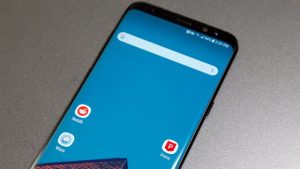 With just two days to go until the Galaxy S8 and Galaxy S8+ are released, the verdict is in: Samsung’s new flagship smartphones are fantastic. I published my full in-depth Galaxy S8 review on Tuesday morning, and my feelings on the new flagship were quite clear. Samsung has actually managed to out-design Apple with new smartphones that not only look better than the iPhone 7 and the 7 Plus, they feel better as well thanks to Samsung’s smart curved design, which helps the phones sit more comfortably in the hand.
With just two days to go until the Galaxy S8 and Galaxy S8+ are released, the verdict is in: Samsung’s new flagship smartphones are fantastic. I published my full in-depth Galaxy S8 review on Tuesday morning, and my feelings on the new flagship were quite clear. Samsung has actually managed to out-design Apple with new smartphones that not only look better than the iPhone 7 and the 7 Plus, they feel better as well thanks to Samsung’s smart curved design, which helps the phones sit more comfortably in the hand.
Of course, the new Galaxy S8 is much more than just a pretty face. It also offers a new 10nm processor and software optimizations that come closer than ever before to matching the iPhone’s performance (closer, yes, but the gap is still quite wide), as well as a ton of nifty features users will appreciate.
While the design is clearly the best thing about Samsung’s new phones, there’s plenty more to look forward to — and the best thing about the new Galaxy S8 and Galaxy S8+ aside from the design is actually something people were complaining about ahead of the phones’ unveiling.
If you haven’t already read our full Galaxy S8 review, you should definitely check it out ahead of this Friday’s launch. We also followed up the review with two supplemental posts that pitted the Galaxy S8 and S8+ against their top rivals, the iPhone 7 and iPhone 7 Plus. In those posts, we covered 5 ways the Galaxy S8 is better than the iPhone 7 and 5 ways the iPhone 7 is better than the Galaxy S8.
There’s one terrific Galaxy S8 feature that wasn’t covered in either of those two supplemental posts, though, and it might come as a surprise to some smartphones fans.
Ahead of Samsung’s Galaxy S8 announcement last month, all of the phones specs leaked before being confirmed by Samsung. We learned that Samsung’s new flagships would be powered by next-generation 10nm processors, we learned they would have huge new Super AMOLED displays with QHD+ resolution, and we learned about everything else Samsung had in store for the new phones. Among those details was the revelation that the Galaxy S8 and S8+ would feature the exact same 12-megapixel Dual Pixel camera as the Galaxy Note 7 and the year-old Galaxy S7 and S7 edge. A number of Android fans were upset by the news.
When it comes to flagship smartphones, we’ve been trained to expect improvements each year in every key area. We want better displays, more powerful processors, bigger batteries, and of course better cameras. But in 2017, Samsung decided to use the exact same camera hardware that it has been using for the past year.
If Samsung’s flagship phones had a camera that was not on par with comparable smartphones from rival vendors, this would probably be a huge problem. But as anyone who has ever owned a Galaxy S7, S7 edge or Note 7 knows, that’s not the case at all.
Samsung’s Dual Pixel camera was one of the best in the world when it first appeared on the S7, and it’s still one of the best cameras in the world today. In fact, I would argue that its only real competition comes from the Google Pixel and the iPhone 7, both of which were release long after the Galaxy S7. Among these three phones, I think it’s impossible to name a clear winner. Also of note, Samsung says it has made several updates on the software side to help with things like low-light performance (which, by the way, was already quite impressive on the S7 and Note 7).
I’ve been carrying the Galaxy S8+ with me ever since I received my review unit last week, and I’ve been using it almost exclusively to take photos. I am thoroughly impressed. I’ve snapped all sorts of images, from outdoor shots in great lighting, to indoor close-ups, to portraits, and everything in between. Of course, I’ve also taken plenty of pictures of my dog.
Alongside battery life, the camera is obviously one of the most important features of a smartphone. Most people don’t even own a dedicated camera anymore because there’s really no reason to… especially if you have a Galaxy S8 or Galaxy S8+. The Infinity Display design is definitely the best thing about Samsung’s new flagship smartphones, but the camera truly is a close second.
